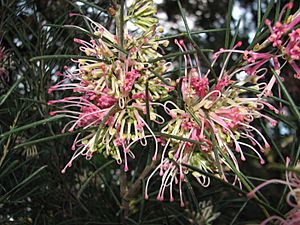Hakea verrucosa facts for kids
Quick facts for kids Hakea verrucosa |
|
|---|---|
 |
|
| Scientific classification | |
| Genus: |
Hakea
|
| Species: |
verrucosa
|
Hakea verrucosa is a cool shrub that belongs to the Proteaceae plant family. It's special because it only grows naturally in the southwest part of Western Australia. This plant has big, beautiful flowers that hang down, and they can be white, deep pink, or even red! Its leaves are stiff and look a bit like needles.
Contents
What Does Hakea Verrucosa Look Like?
Hakea verrucosa is a spiky, spreading shrub that can grow between 0.8 to 2.6 meters (about 2.6 to 8.5 feet) tall. It doesn't have a special woody base called a lignotuber that helps some plants regrow after fire. Its small branches are often covered in short, rusty-colored hairs.
Leaves and Flowers
The leaves are green and shaped like thin cylinders, about 2 to 6.3 centimeters (0.8 to 2.5 inches) long and 1 to 1.5 millimeters wide. They end in a sharp point. These smooth leaves often point in one direction from the branch.
The flowers are very showy and hang down in clusters. Each cluster has 7 to 14 flowers that can be white, pink, or red. They grow from the leaf joints or on older parts of the wood. Each flower cluster sits on a small stalk about 3 to 16 millimeters long. The individual flower stems are 2 to 5.4 millimeters long. The main part of the flower, called the perianth, is 6 to 9 millimeters long. It starts out creamy white and then turns pink as it gets older. The long, slender part of the flower that holds the pollen, called the pistil, is about 21 to 25 millimeters long. You can usually see these beautiful flowers between May and August.
Fruit of the Plant
After flowering, the plant produces fruit that looks like an egg, but it's a bit slanted. These fruits are about 2.2 to 3.1 centimeters (0.9 to 1.2 inches) long and 1.2 to 1.4 centimeters (0.5 to 0.6 inches) wide. They have bumpy, blister-like spots on them and taper into two small horns, about 2.5 to 5 millimeters long.
How Hakea Verrucosa Got Its Name
This plant was first officially described in 1865 by a botanist named Ferdinand von Mueller. He was the Victorian Government Botanist at the time. He wrote about it in his book Fragmenta Phytographiae Australiae. The name verrucosa comes from a Latin word meaning "warty." This refers to the bumpy surface of the plant's seeds.
Where Hakea Verrucosa Grows
Hakea verrucosa grows in different types of environments. You can find it in areas with heath (low-growing shrubs) and in open woodlands. It prefers sandy soil mixed with loam, especially near creeks, or in clay and gravel soils. Its natural home stretches along the coast of Western Australia, from a town called Jerramungup all the way to Esperance.
Using Hakea Verrucosa in Gardens
This plant is pretty tough and can handle frost, which means it can survive cold temperatures. If you want to grow it, make sure the soil drains well, so water doesn't sit around its roots. Because it grows in a dense, spiky way, it makes a great home for wildlife and can also act as a good windbreak in a garden.
Protecting Hakea Verrucosa
The good news is that Hakea verrucosa is currently classified as "not threatened" by the Western Australian Government's Department of Parks and Wildlife. This means it's not in danger of disappearing right now.

